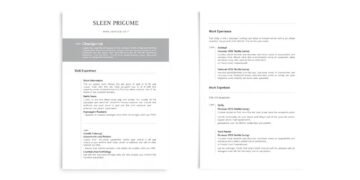Preparing for a technical challenge can feel overwhelming. With so many areas to focus on, where do you even begin? Whether you’re aiming to master data structures, refine system design skills, or ace mock sessions, a structured approach is key.
This guide offers a comprehensive 13-step plan to help you navigate the process. It combines essential technical skills with practical strategies to boost your confidence. From avoiding common mistakes to following expert timelines, every step is designed to maximize your preparation.
With insights from industry professionals like ex-Meta engineer Yangshun, you’ll gain actionable tips to streamline your efforts. Ready to take your preparation to the next level? Let’s dive in.
Key Takeaways
- Follow a 13-step guide to cover all aspects of technical challenges.
- Combine data structures and system design preparation for a well-rounded approach.
- Use mock sessions to build confidence and identify areas for improvement.
- Avoid common pitfalls like rushing into solutions or poor variable naming.
- Follow expert-recommended timelines for effective preparation.
1. Understand the Coding Interview Process
Navigating the technical challenge process requires clarity and preparation. Knowing what to expect can help you approach it with confidence. Whether you’re applying to a top-tier company or a startup, the structure often follows a similar pattern.
What to Expect in a Coding Interview
Most technical evaluations, especially in FAANG companies, last around 45 minutes. These sessions typically use collaborative coding environments like CoderPad or Zoom. A strong internet connection and a quiet space are essential for remote interviews.
The process usually starts with a brief introduction, followed by 35 minutes of problem-solving. The session ends with a short Q&A. Whiteboard interviews, though less common now, require careful space management for code modifications.
Types of Questions: DSA, Systems Design, and Behavioral
Technical challenges often focus on data structures and algorithms (DSA). For senior roles, systems design questions are common. These assess your ability to architect scalable solutions.
Behavioral questions are also part of the process. They often use the STAR (Situation, Task, Action, Result) format to evaluate your soft skills. Remember, 61% of top candidates fail due to poor communication, not technical ability.
By understanding these components, you can tailor your preparation effectively. This knowledge will help you approach the process with confidence and clarity.
2. Build a Strong Foundation in Data Structures and Algorithms
Mastering data structures and algorithms is a cornerstone of technical success. These concepts are the building blocks for solving complex problems efficiently. Whether you’re working on a simple list or a large-scale system, understanding these fundamentals is crucial.
Essential Data Structures to Master
Arrays and hash tables are among the most frequently used data structures. Arrays appear in 78% of LeetCode problems, while hash tables are used in 92% of cases. These structures are versatile and form the basis for many advanced concepts.
Other important structures include priority queues, often implemented using heaps. Graphs are also essential, especially for problems involving social network analysis or pathfinding. Understanding these structures will help you tackle a wide range of challenges.
Key Algorithms Every Candidate Should Know
Depth-First Search (DFS) and Breadth-First Search (BFS) are critical for tree and graph traversal. They appear in 65% of tree-related questions. Dynamic programming is another powerful technique, solving 34% of hard problems efficiently.
Real-world applications of these algorithms are vast. For example, Tries are used in autocomplete systems, while Union-Find helps solve network connectivity issues. Knowing these algorithms can give you an edge in technical evaluations.
One common pitfall is ignoring cycle detection in graph problems. Always double-check your solutions to avoid such mistakes. With practice, you’ll gain confidence in applying these techniques effectively.
3. Create a Study Plan for Coding Interview Prep
A well-structured study plan is your roadmap to success in technical evaluations. It helps you manage your time effectively and ensures you cover all essential topics. Without a clear plan, it’s easy to feel overwhelmed or miss critical areas.
Setting Realistic Goals and Timelines
Start by breaking your preparation into manageable phases. A recommended 6-week plan with 20 hours per week works well for most candidates. This totals 120 hours, giving you ample time to focus on core concepts.
Phase-based learning is effective. Spend the first two weeks mastering data structures and algorithms. Dedicate one week to system design and another to mock sessions. This approach ensures a balanced and thorough preparation process.
Balancing Theory and Practice
Allocate 70% of your study time to hands-on coding and 30% to theory review. Top performers solve 2-3 problems daily, analyzing each solution in detail. This balance helps reinforce concepts while improving problem-solving skills.
Use techniques like spaced repetition to retain algorithms longer. Track your progress with a matrix to identify weak areas, such as sliding window patterns. Pair programming sessions twice a week can also enhance collaborative learning.
Finally, consider the Pomodoro technique for focused 25-minute sessions. This method boosts efficiency and keeps you motivated throughout your preparation.
4. Master Problem-Solving Techniques
Effective problem-solving is a skill that can be honed with the right techniques and strategies. A structured approach not only saves time but also increases the chances of finding optimal solutions. Whether you’re tackling a simple task or a complex problem, these methods will guide you through the process.
Breaking Down Complex Problems
One of the most effective ways to approach a problem is by breaking it into smaller, manageable parts. The RUBY method—Read, Understand, Break down, Yes/no cases—is a proven framework. It ensures you fully grasp the requirements before diving into the code.
Another critical step is analyzing the time-space tradeoff. This helps you decide whether to prioritize speed or memory efficiency in your algorithm. Always identify edge cases, such as empty inputs or duplicates, to ensure your solution is robust.
Common Problem-Solving Patterns
Recognizing patterns can significantly speed up your problem-solving. For example, the Sliding Window technique is used in 23% of problems, while Two Pointers appear in 19%. The Fast & Slow pattern is another powerful tool, especially for linked list challenges.
Practice pattern recognition using platforms like LeetCode. Focus on tagged problems to build familiarity with these techniques. For instance, solving “Trapping Rain Water” using dual pointers is a great way to apply these concepts in real-world scenarios.
5. Practice Coding Questions Regularly
Consistent practice is the cornerstone of mastering technical problem-solving. By dedicating time to solve questions daily, you build both confidence and competence. Platforms like LeetCode and HackerRank offer curated problem lists to help you focus on the most relevant challenges.
Top Platforms for Coding Practice
LeetCode is a favorite among FAANG hires, with 78% of candidates using its premium features. HackerRank reports that daily 30-minute sessions improve performance by 63%. For beginners, CodeSignal’s arcade mode provides a gentle introduction to problem-solving.
Mock interview simulators like Pramp and Interviewing.io are excellent for simulating real-world scenarios. These tools help you get comfortable with time-boxed sessions, mimicking the pressure of actual evaluations.
How to Approach LeetCode and Other Resources
Start with curated problem lists like Blind 75 or Grind 169. These sets cover core concepts and comprehensive challenges. Time-box your practice to 25 minutes per problem, ensuring you stay within interview-like constraints.
After solving a problem, analyze your approach, complexity, and potential optimizations. Community resources like NeetCode’s YouTube channel, with 1.2 million subscribers, offer detailed explanations to deepen your understanding.
By integrating these strategies into your routine, you’ll develop a structured approach to problem-solving. This method ensures you’re well-prepared for any technical challenge that comes your way.
6. Prepare for Systems Design Interviews
Systems design interviews require a unique blend of technical knowledge and strategic thinking. Unlike coding challenges, these sessions assess your ability to architect scalable and efficient solutions. Mastering this area is crucial for roles that involve building large-scale systems.
Understanding Systems Design Basics
At its core, systems design involves creating solutions that handle large amounts of data efficiently. A 4-step framework, used by 92% of Google interviewers, is a great starting point. This includes defining requirements, sketching a high-level design, identifying bottlenecks, and refining the solution.
Key components like load balancing (used in 81% of systems), sharding (79%), and CDNs (68%) are essential to understand. These elements ensure that systems can scale effectively while maintaining performance. Familiarity with these concepts will help you approach interview questions with confidence.
Common Systems Design Questions and Solutions
Real-world case studies, such as Twitter’s search system or Uber’s ride-matching algorithm, are often used in interviews. These examples test your ability to apply design principles to practical scenarios. For instance, capacity estimation formulas like QPS × data size per request are frequently used to evaluate scalability.
Tradeoff analysis is another critical skill. You’ll need to weigh options like SQL vs. NoSQL or consistency vs. availability. Tools like Excalidraw (free) or Lucidchart (pro) can help you visualize your designs during the process.
By mastering these concepts and practicing with real-world examples, you’ll be well-prepared to tackle any systems design challenge a company might throw your way.
7. Develop Effective Communication Skills
Strong communication skills are essential for success in technical evaluations. While technical expertise is crucial, 67% of rejected candidates fail due to poor communication. Clear articulation of your thought process and collaboration with the interviewer can significantly impact your performance.
How to Explain Your Thought Process
Start by actively listening to the problem statement. Use verbal scaffolding to outline your approach, such as, “I’m considering approach X because…” This demonstrates clarity and logical reasoning. Break down complex problems into smaller steps and explain each one as you go.
Whiteboarding is a common tool in technical evaluations. Use a left-to-right flow and color coding to make your explanations visually clear. This helps the interviewer follow your logic and ensures you stay organized.
Collaborating with Interviewers During the Interview
Technical evaluations are often collaborative. If the interviewer provides hints, acknowledge them. For example, “Are you suggesting we try a hash map approach?” This shows you’re open to feedback and can adapt your strategy.
Pair programming simulations are another effective way to practice collaboration. Treat the session as a dialogue, explaining your thought process while coding. This approach builds confidence and prepares you for real-world scenarios.
By mastering these communication techniques, you’ll not only solve problems effectively but also leave a lasting impression on your interviewer.
8. Optimize Your Coding Environment
A well-optimized workspace can significantly boost your efficiency and focus. Whether you’re solving complex problems or refining your skills, the right setup saves time and enhances your workflow. From IDE configurations to hardware choices, every detail matters.
Setting Up Your IDE and Tools
Start by customizing your IDE for maximum productivity. VS Code users, for example, solve problems 23% faster with extensions like LeetCode and Code Runner. Adjust font size, theme, and linters to create an interview-ready setup.
Use custom code snippets for common patterns to speed up your code writing. For browser-based tools, create separate profiles to keep interview tabs organized. These small tweaks can make a big difference in your practice sessions.
Keyboard Shortcuts and Efficiency Tips
Mastering keyboard shortcuts is a game-changer. Multi-cursor (Alt+Click) and Quick Fix (Ctrl+.) are must-knows for faster editing. These shortcuts reduce manual effort and help you focus on problem-solving.
For hardware, consider a mechanical keyboard and a secondary monitor. These tools enhance comfort and allow for better multitasking. If using CoderPad, activate auto-complete to streamline your workflow during evaluations.
By optimizing your coding environment, you’ll work smarter, not harder. These adjustments ensure you’re fully prepared to tackle any challenge with confidence.
9. Simulate Real Interviews with Mock Practice
Mock practice is a game-changer for mastering technical evaluations. It bridges the gap between theory and real-world application, helping you refine your skills under pressure. According to a Stanford study, candidates who complete three mock interviews see a 58% increase in success rates.
Benefits of Mock Interviews
Mock interviews replicate the actual evaluation environment, allowing you to identify strengths and weaknesses. They help you get comfortable with time constraints, improve communication, and build confidence. Platforms like Interview Kickstart and Exponent offer structured simulations tailored to your needs.
How to Conduct Effective Mock Interviews
Start by creating a full-dress rehearsal checklist. Ensure your webcam, timer, and code submission tools are ready. Use a feedback template focusing on technical accuracy, communication, and time management. Partner with peers from coding communities for diverse perspectives.
Record your sessions to analyze non-verbal cues like body language and tone. Gradually increase the difficulty of questions, moving from easy to medium and hard. This progressive approach ensures you’re prepared for any challenge.
By integrating mock practice into your routine, you’ll gain a deeper understanding of the evaluation process. This hands-on approach not only boosts your skills but also prepares you to tackle real-world scenarios with confidence.
10. Review and Analyze Your Performance
Analyzing your performance is a critical step in improving your technical skills. Regular reviews help you identify what’s working and where you need to improve. Keeping a performance journal, for example, has been shown to boost retention by 37%.
Identifying Strengths and Weaknesses
Start by categorizing your errors. Common mistakes include off-by-one errors (28%) and null pointers (19%). Use an error matrix to separate syntax, logic, and optimization issues. This helps you focus on specific areas for improvement.
Conduct a gap analysis to compare your skills with your target company’s requirements. For instance, if you struggle with dynamic programming, dedicate more time to mastering it. Weekly progress reviews with metrics tracking ensure you’re on the right path.
Learning from Mistakes
Mistakes are valuable learning opportunities. Instead of just noting what went wrong, dig deeper to understand why. Root cause analysis helps you avoid repeating the same errors. For example, if a solution failed due to poor variable naming, focus on improving your coding practices.
Create a correction workflow: re-attempt the problem, compare your new approach with the original, and annotate the differences. This method reinforces learning and builds confidence. Seeking feedback from peers or mentors can also provide fresh perspectives.
By consistently reviewing and analyzing your performance, you’ll turn weaknesses into strengths and refine your problem-solving skills. This structured approach ensures continuous growth and prepares you for any challenge.
11. Stay Calm and Confident During the Interview
Staying composed during high-pressure situations is a skill that can be developed. Your ability to remain calm and focused can make a significant difference in your performance. This section provides practical strategies to manage anxiety and maintain a positive mindset throughout the process.
Techniques to Manage Interview Anxiety
Anxiety is natural, but it can be controlled. The 4-7-8 breathing technique, for example, reduces stress by 41%. Inhale for 4 seconds, hold for 7, and exhale for 8. This simple exercise can help you regain focus quickly.
Power posing is another effective method. Standing in a confident posture for two minutes increases confidence markers by 19%. Try this before your interview to boost your self-assurance.
Maintaining a Positive Mindset
Start with a pre-interview ritual. Meditate for 5 minutes or solve a warm-up problem to get into the right mindset. These activities help you transition into a focused state.
Cognitive reframing is also powerful. Instead of viewing the session as a test, think of it as a collaborative problem-solving exercise. This shift in perspective can reduce pressure and improve your performance.
Manage your time effectively by signaling your approach. For example, say, “I’ll prototype first, then optimize.” This keeps the process organized and demonstrates clarity of thought.
12. Prepare for the Final Stages of the Interview Process
The final stages of the interview process are just as critical as the initial preparation. This phase is your opportunity to leave a lasting impression and demonstrate your genuine interest in the company. By asking thoughtful questions and following up effectively, you can stand out from other candidates.
Asking Insightful Questions at the End
When the interviewer asks if you have any questions, seize the moment. Focus on topics that show your curiosity and alignment with the company’s goals. Start with team dynamics, such as, “How does the team collaborate on projects?”
Next, explore technical challenges. For example, “What are the biggest design hurdles your team currently faces?” Finally, inquire about growth opportunities, like, “What does career progression look like in this role?” Strong questions can increase your offer likelihood by 29%.
Following Up After the Interview
A timely follow-up is essential. Send a thank-you email within 24 hours, as 73% of hires do. Use a professional template that reiterates your interest and highlights key points from the discussion.
Connect with your interviewers on LinkedIn to maintain a professional relationship. If the outcome isn’t favorable, conduct a post-mortem analysis to identify areas for improvement. This approach ensures you’re better prepared for future opportunities.
13. Conclusion: Ace Your Coding Interview with Confidence
Approaching technical evaluations with a clear strategy ensures you’re ready to tackle any challenge. Mastering data structures, systems design, and effective communication are the core pillars of success. These skills, combined with consistent practice, will help you perform at your best.
Before your evaluation, verify your final checklist. Ensure you’ve covered all essential topics and practiced under timed conditions. Many candidates have turned multiple rejections into FAANG offers by refining their approach and staying persistent.
Even after your evaluation, continue learning. Explore advanced topics in software engineering and join communities like Discord groups or coding meetups. These resources provide ongoing support and opportunities to grow.
With the right mindset and preparation, you can confidently navigate any technical challenge. Stay focused, keep improving, and success will follow.
FAQ
What should I expect in a coding interview?
You can expect questions on data structures, algorithms, systems design, and behavioral scenarios. The goal is to assess your technical skills and problem-solving abilities.
Which data structures are essential to master?
Focus on arrays, linked lists, stacks, queues, trees, graphs, and hash tables. These are commonly tested in technical assessments.
How can I create an effective study plan?
Set realistic goals, allocate time for theory and practice, and use platforms like LeetCode to solve problems regularly.
What are common problem-solving patterns?
Patterns like two pointers, sliding window, and dynamic programming are frequently used to tackle complex problems efficiently.
How do I prepare for systems design interviews?
Start with understanding the basics of system architecture, scalability, and load balancing. Practice designing systems like URL shorteners or social media platforms.
Why are mock interviews important?
Mock interviews simulate real scenarios, helping you practice communication, time management, and problem-solving under pressure.
How can I manage interview anxiety?
Practice deep breathing, stay positive, and focus on your preparation. Confidence comes from being well-prepared.
What should I ask at the end of an interview?
Ask about the team’s challenges, company culture, or the next steps in the hiring process. It shows your interest and engagement.









